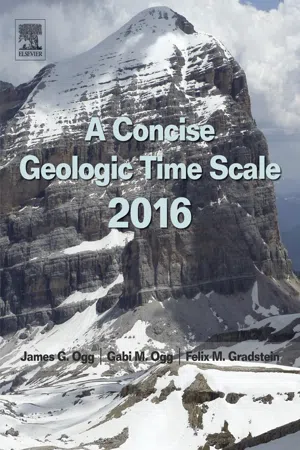Geologic time scale and this book
A standardized geologic time scale is the framework for deciphering and understanding the long and complex history of our planet Earth. We are constantly improving our knowledge of that history including the intertwined feedbacks among the evolution of life, the climatic and geochemical trends and oscillations, the sea-level withdrawals and transgressions, the drifting tectonic plates and major volcanic upheavals, and the radioisotopic and astronomical-cycle dating of deposits. In turn, this knowledge of past relationships and feedbacks enable us to make predictions about our own future impacts on our planet.
The challenges and major accomplishments of geoscientists are to integrate these diverse interpretations of the global stratigraphic record, to apply an age model (“linear time”) to that geologic record, and to assign a standardized and precise international terminology of subdivisions. The publications of A Geologic Time Scale 1989 (Harland et al., 1989), of A Geologic Time Scale 2004 (Gradstein et al., 2004; under the scientific auspices of the International Commission on Stratigraphy, ICS), and of The Concise Geologic Time Scale (Ogg et al., 2008) spurned dedicated research and collective activities to bring about improvements in stable-isotope stratigraphy, radioisotopic and cyclostratigraphic dating of stage boundaries, and formal definitions of stage boundaries.
Any synthesis of this geologic time scale is a status report in this grand undertaking. This Concise Geologic Time Scale 2016 handbook presents a brief summary of the current scale and some of the most common means of global stratigraphic correlation and age calibration as graphics with brief explanatory texts. These rely extensively on the two-volume Geologic Time Scale 2012 (GTS2012) compilation (Gradstein et al., 2012), and readers who desire more background or details should use that reference. This handbook does incorporate some selected important advances in stratigraphic scale calibration, in new ratified or candidate international divisions and in their scaling to numerical time.
Each chapter in this handbook, which generally spans a single geologic system or period, includes:
1. International divisions of geologic time, with graphics for ratified bases of series/epoch definitions (Global Boundary Stratotype Sections and Points (GSSPs)). GSSPs for stage-level divisions are diagrammed in GTS2012, at the website of the Geologic TimeScale Foundation, and at the websites of the ICS subcommissions.
2. Major paleontological zonations, geomagnetic polarity reversals, selected geochemical trends (usually isotopic ratios of carbon and of oxygen), interpreted sea-level history, and other events or zones.
3. Explanation of the derivation and uncertainties for the current numerical age model of the stratigraphic boundaries and events, and a summary of any incorporated revised ages assigned to stage boundaries compared to GTS2012.
4. Selected references and websites for additional information.
The stratigraphic scales in the diagrams are a small subset of the compilations and databases in GTS2012 and other syntheses. One can generate custom charts from these databases using the public TimeScale Creator visualization system available at www.tscreator.org (which mirrors to https://engineering.purdue.edu/Stratigraphy/tscreator/).
International divisions of geologic time and their global boundaries (GSSPs)
A common and precise language of geologic time is essential to discuss Earth’s history. Hence, a chart of international ratified stratigraphic units (e.g., Fig. 1.1) is a vital part of the scientific toolbox carried by each earth scientist to do his or her job. Ideally, each stage boundary is defined at a precise Global Boundary Stratotype Section and Point (GSSP) (e.g., McLaren, 1978; Remane, 2003). This GSSP is a point in the rock record of a specific outcrop at a level selected to coincide with one or more primary markers for global correlation (lowest occurrence of a fossil, onset of a geochemical anomaly, a distinctive geomagnetic polarity reversal, etc.). The majority of ratified GSSP placements and the terminology for the geologic stages of Silurian through Quaternary were selected to correspond closely to traditional European usage (e.g., Emsian, Campanian, Selandian). In contrast, those in the Cambrian and Ordovician were established after an international effort to identify a set of global events that could be reliably correlated, therefore many of the ratified GSSPs have new stage names (e.g., Fortunian, Katian) (Fig. 1.1).
Divisions of the preserved rock record, geologic time, and assigned numerical ages are separate but related concepts which are united through the GSSP concept. Chronostratigraphic (“rock time”) units are the rocks formed during a specified interval of geologic time. Therefore, the Jurassic “System” is the body of rocks that formed during the Jurassic “Period.” A similar philosophy of clarifying whether one is discussing rocks or time applies to stratigraphic successions in which the terms of “lower, upper, and...
